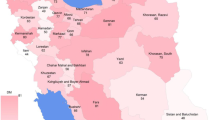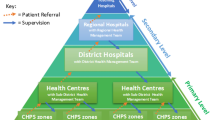Abstract
Background
Unequal access to healthcare between individuals or populations does not imply the existence of inequities as it must be controlled for differences in need. This is usually done either via direct or indirect standardization methods.
Objective
We study the degree of equity in the availability of public primary healthcare centers between the 134 municipalities of the Buenos Aires province (Argentina) with a novel application of an existing statistical tool.
Methods
Stochastic frontier analysis was applied to estimate the number of primary care facilities that should be available in each municipality according to demographic variables (population under age 4 years and above age 65 years), as they are the population groups with higher healthcare needs.
Results
Under all specifications tried, the endowment of primary healthcare centers at the municipal level tends to increase (but less than proportionally) with the size of the population at risk. In addition, wealthier jurisdictions tend to be more equitable but also more heterogeneous.
Conclusions
Stochastic frontier analysis allows us to discriminate between those districts that, according to their needs, are underserved, from those who have a surplus of health facilities. This approach can also help to explore what other elements might be responsible for the observed inequities.


Similar content being viewed by others
Notes
The concentration curve plots the cumulative percentage of the health resource variable (y-axis) against the cumulative percentage of the sample, ranked by living standards.
References
Rice N, Smith P. Ethics and geographical equity in health care. J Med Ethics. 2001;27:256–61.
Whitehead M. The concepts and principles of equity and health. Int J Health Serv. 1992;22(3):429–45.
Culyer AJ. Equity-some theory and its policy implications. J Med Ethics. 2000;27(4):275–83.
Muldoon LK, Hogg WE, Levitt M. Primary care (PC) and primary health care (PHC): what is the difference? Can J Pub Health/Rev Can San Pub. 2006;97(5):409–11.
Guagliardo MF. Spatial accessibility of primary care: concepts, methods and challenges. Int J Health Geogr. 2004;3(1):1.
Allin S, Masseria C, Sorenson C, et al. Measuring inequalities in access to health care: a review of the indices. Brussels: European Commission; 2007. http://eprints.lse.ac.uk/29837/. Accessed 19 Sep 2016.
Tao Y, Henry K, Zou Q, Zhong X. Methods for measuring horizontal equity in health resource allocation: a comparative study. Health Econ Rev. 2014;4(1):1.
Wagstaff A, Van Doorslaer E. Equity in health care finance and delivery. Handb Health Econ. 2000;1:1803–62.
O’Donnell O, van Doorslaer E, Wagstaff A, Lindelow M. Analyzing health equity using household survey data: a guide to techniques and their implementation. Washington, DC: The World Bank; 2008.
Wagstaff A, Van Doorslaer E. Measuring and testing for inequity in the delivery of health care. J Hum Res. 2000;716–33.
Wagstaff A, Paci P, van Doorslaer E. On the measurement of inequalities in health. Social Sci Med. 1991;33:545–57.
Kakwani NC, Wagstaff A, van Doorlsaer E. Socioeconomic inequalities in health: Measurement, computation and statistical inference. J Econ. 1997;77(1):87–104.
Berg S. Water utility benchmarking: measurement, methodologies, and performance incentives. London: IWA Publishing; 2010.
Battese GE, Coelli TJ. A model for technical inefficiency effects in a stochastic frontier production function for panel data. Empir Econ. 1995;20:325–32.
Das A. Recent development in stochastic frontier model with correlated error components. Indore Manag J. 2013;5:65–80.
Field K. Measuring the need for primary health care: an index of relative disadvantage. Appl Geogr. 2000;20(4):305–32.
McGrail M, Humphreys J. The index of rural access: an innovative integrated approach for measuring primary care Access. BMC Health Serv Res. 2009;9:124. doi:10.1186/1472-6963-9-124.
Instituto Nacional de Estadísticas y Censos. Censo Nacional de Población y Vivienda 2010. Resultados definitivos. http://www.indec.gov.ar/nivel4_default.asp?id_tema_1=2&id_tema_2=41&id_tema_3=135. Accessed 22 Dec 2015.
Lódola A, Beigo E, Morra F. Economía de los Gobiernos Municipales. Teoría y Aplicaciones a la Argentina: Producción de los Municipios de la Provincia de Buenos Aires. Facultad de Ciencias Económicas UNLP, Documento de Trabajo No. 98. 2010. http://www.depeco.econo.unlp.edu.ar/doctrab/doc98.pdf. Accessed 12 Feb 2016.
Provincia de Buenos Aires. Dirección Provincial de Estadística. http://www.estadistica.ec.gba.gov.ar/dpe/Estadistica/Bs.As2001-2005/pobla.htm. Accessed 18 Dec 2015.
Provincia de Buenos Aires. Ministerio de Salud. http://www.ms.gba.gov.ar/estadisticas/. Accessed 10 Dec 2015.
Kumbhakar SC, Lovell CA. Stochastic frontier analysis. Cambridge: Cambridge University Press; 2000.
Arredondo A, Parada I, Orozco E, Garcia E. Impact of decentralization on health financing in Mexico. Rev Saude Publica. 2004;38(1):121–9.
Guimaraens L. Modalidades de descentralización en el sector salud y sus contribuciones a la equidad: elementos fundamentales para la formulación de un marco normativo. Serie informes técnicos No. 76. Programa de Políticas Públicas y Salud. Washington DC: Organización Panamericana de la Salud; 2001.
Okorafor O, Thomas S. Protecting resources for primary health care under fiscal federalism: options for resource allocation. Health Policy Plan. 2007;22(6):415–26.
Maceira D, Olaviaga S, Kremer P, Cejas C. Centros de Atención Primaria de Salud: radiografía de su distribución en la Argentina. CIPPEC Políticas Públicas Análisis No. 30. 2006. http://www.cippec.org/documents/10179/51825/30+DPP+A+Salud,%20CAPs+distribuci%C3%B3n+en+la+Argentina,%20Maceira,%20Olaviaga,%20Kremer+y+Cejas,%202006.pdf/e53b91f2-2ed1-4476-ac6e-0f949f0b7d4c. Accessed 12 Feb 2016.
Chiara M, Di Virgilio M, Moro J. Inequidades en la atención de la salud en el Gran Buenos Aires. Una mirada desde la gestión local. Postdata. 2009;14(1):97–128.
Tobar F. La Red Pública de Atención Primaria de la Salud en Argentina. Diagnóstico y desafíos. Informe. 2006. http://www.federicotobar.com.ar/nf_pdf5/La_Red_Publica.pdf. Accessed 29 Feb 2016.
Ministerio de Salud de la Nación. Comunicación y Salud desde una Perspectiva de Derechos. Guía de comunicación para equipos de salud. 2015. http://www.msal.gob.ar/plan-reduccion-mortalidad/boletin/b04/pdf/2013_comunicacion_salud_ALTA_WEB.pdf. Accessed 22 Nov 2016.
Acknowledgements
The authors thank Federico Barragan from the Laboratory of Geotechnology (Universidad Nacional del Sur) for technical assistance with maps.
Author information
Authors and Affiliations
Corresponding author
Ethics declarations
Funding
This work was supported by Universidad Nacional del Sur Science and Technology Secretary [24E/100].
Conflict of interest
Valentina Viego, María Florencia Arnaudo, and Fernando Lago declare that there are no conflicts of interest.
Rights and permissions
About this article
Cite this article
Arnaudo, F., Lago, F. & Viego, V. Assessing Equity in the Provision of Primary Healthcare Centers in Buenos Aires Province (Argentina): A Stochastic Frontier Analysis. Appl Health Econ Health Policy 15, 425–433 (2017). https://doi.org/10.1007/s40258-016-0303-9
Published:
Issue Date:
DOI: https://doi.org/10.1007/s40258-016-0303-9




